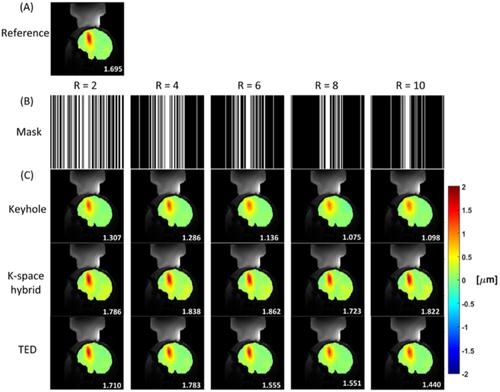当前位置:
X-MOL 学术
›
NMR Biomed.
›
论文详情
Our official English website, www.x-mol.net, welcomes your
feedback! (Note: you will need to create a separate account there.)
Highly accelerated magnetic resonance acoustic radiation force imaging for in vivo transcranial ultrasound focus localization: A comparison of three reconstruction methods
NMR in Biomedicine ( IF 2.7 ) Pub Date : 2021-08-15 , DOI: 10.1002/nbm.4598 Yangzi Qiao 1 , Yanbin Li 1, 2 , Qingpu Leng 1, 3 , Hui Zhou 1, 3 , Xiaojing Long 1 , Jo Lee 1 , Yadong Chen 2 , Xin Liu 1 , Hairong Zheng 1 , Chao Zou 1
NMR in Biomedicine ( IF 2.7 ) Pub Date : 2021-08-15 , DOI: 10.1002/nbm.4598 Yangzi Qiao 1 , Yanbin Li 1, 2 , Qingpu Leng 1, 3 , Hui Zhou 1, 3 , Xiaojing Long 1 , Jo Lee 1 , Yadong Chen 2 , Xin Liu 1 , Hairong Zheng 1 , Chao Zou 1
Affiliation

|
Magnetic resonance acoustic radiation force imaging (MR-ARFI) is a promising tool for transcranial neurosurgery planning and monitoring. However, the ultrasound dose during ARFI is quite high due to the high intensity required and the repetitive ultrasound sonication. To reduce the ultrasound deposition and prevent unwanted neurological effects, undersampling in k-space data acquisition is adopted in the current study. Three reconstruction methods, keyhole, k-space hybrid and temporal differences (TED) compressed sensing, the latter two of which were initially proposed for MR thermometry, were applied to the in vivo transcranial focus localization based on MR-ARFI data in a retrospective way. The accuracies of the three methods were compared with the results from the fully sampled data as reference. The results showed that the keyhole method tended to smooth the displacement map and underestimate the peak displacement. The K-space hybrid method was better at recovering the displacement map and was robust to the undersampling pattern, while the TED method was more time efficient under a higher image resolution. For an image of a lower resolution, the K-space hybrid and TED methods were comparable in terms of accuracy when a high undersampling rate was applied. The results reported here facilitate the choice of appropriate undersampled reconstruction methods in transcranial focal localization based on MR-ARFI.
中文翻译:

用于体内经颅超声焦点定位的高加速磁共振声辐射力成像:三种重建方法的比较
磁共振声辐射力成像 (MR-ARFI) 是一种很有前途的经颅神经外科手术规划和监测工具。然而,由于需要高强度和重复超声处理,ARFI 期间的超声剂量相当高。为了减少超声沉积并防止不必要的神经系统影响,当前研究采用了 k 空间数据采集中的欠采样。三种重建方法,锁孔、k空间混合和时间差异(TED)压缩传感,后两种最初是为MR测温提出的,以回顾性的方式应用于基于MR-ARFI数据的体内经颅病灶定位. 将三种方法的准确度与作为参考的全采样数据的结果进行比较。结果表明,锁孔法倾向于平滑位移图并低估峰值位移。K 空间混合方法在恢复位移图方面更好,并且对欠采样模式具有鲁棒性,而 TED 方法在更高的图像分辨率下更省时。对于较低分辨率的图像,当应用高欠采样率时,K 空间混合方法和 TED 方法在准确度方面具有可比性。这里报告的结果有助于在基于 MR-ARFI 的经颅病灶定位中选择适当的欠采样重建方法。而 TED 方法在更高的图像分辨率下更省时。对于较低分辨率的图像,当应用高欠采样率时,K 空间混合方法和 TED 方法在准确度方面具有可比性。这里报告的结果有助于在基于 MR-ARFI 的经颅病灶定位中选择适当的欠采样重建方法。而 TED 方法在更高的图像分辨率下更省时。对于较低分辨率的图像,当应用高欠采样率时,K 空间混合方法和 TED 方法在准确度方面具有可比性。这里报告的结果有助于在基于 MR-ARFI 的经颅病灶定位中选择适当的欠采样重建方法。
更新日期:2021-08-15
中文翻译:

用于体内经颅超声焦点定位的高加速磁共振声辐射力成像:三种重建方法的比较
磁共振声辐射力成像 (MR-ARFI) 是一种很有前途的经颅神经外科手术规划和监测工具。然而,由于需要高强度和重复超声处理,ARFI 期间的超声剂量相当高。为了减少超声沉积并防止不必要的神经系统影响,当前研究采用了 k 空间数据采集中的欠采样。三种重建方法,锁孔、k空间混合和时间差异(TED)压缩传感,后两种最初是为MR测温提出的,以回顾性的方式应用于基于MR-ARFI数据的体内经颅病灶定位. 将三种方法的准确度与作为参考的全采样数据的结果进行比较。结果表明,锁孔法倾向于平滑位移图并低估峰值位移。K 空间混合方法在恢复位移图方面更好,并且对欠采样模式具有鲁棒性,而 TED 方法在更高的图像分辨率下更省时。对于较低分辨率的图像,当应用高欠采样率时,K 空间混合方法和 TED 方法在准确度方面具有可比性。这里报告的结果有助于在基于 MR-ARFI 的经颅病灶定位中选择适当的欠采样重建方法。而 TED 方法在更高的图像分辨率下更省时。对于较低分辨率的图像,当应用高欠采样率时,K 空间混合方法和 TED 方法在准确度方面具有可比性。这里报告的结果有助于在基于 MR-ARFI 的经颅病灶定位中选择适当的欠采样重建方法。而 TED 方法在更高的图像分辨率下更省时。对于较低分辨率的图像,当应用高欠采样率时,K 空间混合方法和 TED 方法在准确度方面具有可比性。这里报告的结果有助于在基于 MR-ARFI 的经颅病灶定位中选择适当的欠采样重建方法。









































 京公网安备 11010802027423号
京公网安备 11010802027423号